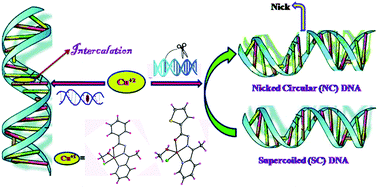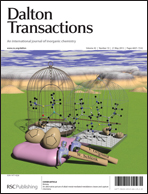Potentially cytotoxic new copper(ii) hydrazone complexes: synthesis, crystal structure and biological properties†
Abstract
A new set of penta-coordinated copper(II) hydrazone complexes containing solvated methanol were synthesized by reacting the hydrazone ligands, 2-acetylpyridine benzoyl hydrazone (HL1) and 2-acetylpyridine thiophene-2-carboxylic acid hydrazone (HL2), with [CuCl2(DMSO)2] and characterized by different spectral methods. Single crystal X-ray diffraction studies of the complexes revealed that both of them, [CuCl(L1)(MeOH)] (1) and [CuCl(L2)(MeOH)] (2), have square pyramidal geometry around the cupric ion, in which the hydrazone is coordinated through NNO atoms along with a molecule of methanol in the apical position. Interaction of the ligands HL1 and HL2 along with the corresponding copper complexes 1 and 2 with calf thymus DNA (CT-DNA) has been estimated by absorption and emission titration methods which revealed that the compounds interacted with CT-DNA through intercalation. Binding of the compounds, i.e., free ligands and complexes (1) and (2) with bovine serum albumin (BSA) protein investigated using UV-visible, fluorescence and synchronous fluorescence spectroscopic methods indicated that there occurred strong binding of copper complexes to BSA over the ligands. Further, the cytotoxicity of the compounds examined in vitro on a panel of cancerous cell lines such as a human cervical cancer cell line (HeLa), a pancreatic cancer cell line (PANC-1), an Ehrlich ascites cancer cell line (EAC) and Dalton's lymphoma ascitic cancer cells (DLA) and a normal mouse embryonic fibroblasts cell line (NIH3) demonstrated that the complexes 1 and 2 possessed superior cytotoxicity than that of well-known commercial anticancer drug cisplatin to the tumor cells but are less toxic to the normal cell line and have emerged as potential candidates for further studies.


 Please wait while we load your content...
Please wait while we load your content...